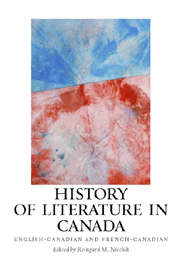Book contents
- Frontmatter
- Contents
- Acknowledgments
- Introduction: Writing a History of Literature in Canada
- I Beginnings
- II The Literature of New France, 1604–1760
- 3 Historical Background
- 4 Literature on New France
- 5 Colonial Literature in New France
- III The Literature of British Canada, 1763–1867
- IV From the Dominion to the Territorial Completion of the Nation, 1867–1918
- V The Modern Period, 1918–1967
- VI Literature from 1967 to the Present
- Further Reading
- Notes on the Contributors
- Index
3 - Historical Background
from II - The Literature of New France, 1604–1760
Published online by Cambridge University Press: 12 September 2012
- Frontmatter
- Contents
- Acknowledgments
- Introduction: Writing a History of Literature in Canada
- I Beginnings
- II The Literature of New France, 1604–1760
- 3 Historical Background
- 4 Literature on New France
- 5 Colonial Literature in New France
- III The Literature of British Canada, 1763–1867
- IV From the Dominion to the Territorial Completion of the Nation, 1867–1918
- V The Modern Period, 1918–1967
- VI Literature from 1967 to the Present
- Further Reading
- Notes on the Contributors
- Index
Summary
NEW FRANCE IS A TERRITORY that once spread from Newfoundland to the Gulf of Mexico. As a French colony it included at least three main regions: Acadia, Canada, and Louisiana (not counting Brazil and Florida). In the context of Canadian history, the term refers to a period corresponding to that of the Ancien Régime in France, dating conventionally from 1534 (the first voyage of Jacques Cartier) to 1763 (the Treaty of Paris, which sanctioned the military conquest by Britain in 1760). New France was in fact the result of six major historical developments: first, the voyages of discovery, beginning officially in 1524 with Verrazzano, followed by Cartier's first voyage; second, the establishment of trading monopolies, starting with De Monts in 1604 (followed by the founding of Quebec City in 1608) and the establishment of the state enterprise Compagnie de la Nouvelle-France in 1627 (succeeded by the Communauté des Habitants in 1645); third, the Sovereign Council in 1663, when France imposed peace on the Indians and the territory of the colony expanded considerably; fourth, the onset of the Indian wars in 1684, further complicated by war with the British colonies; fifth, the “thirty-years peace” (1713–1744), which for the span of one generation allowed social and economic growth in the colony; and sixth, the resumption of war, which ended with the British conquest of 1760. Yet New France was much more than a territory, a period of history, or a colonial society. It was American France, a “France d'Amérique.”
- Type
- Chapter
- Information
- History of Literature in CanadaEnglish-Canadian and French-Canadian, pp. 47Publisher: Boydell & BrewerPrint publication year: 2008

